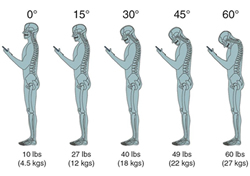Ron Ehrlich says the time we spend poring over our devices is storing up chronic musculoskeletal pain conditions which could cost billions of dollars a year to treat.
 Unfortunately, our modern daily life sees many of us, including our children, spending far too much time at jobs, tasks or ‘leisure’ that promotes poor posture.
Unfortunately, our modern daily life sees many of us, including our children, spending far too much time at jobs, tasks or ‘leisure’ that promotes poor posture.
Sitting is a perfect example of just how far-reaching the health repercussions of bad posture can be.
According to research, the biggest difference between people of average weight and those who are overweight isn’t related to diet or exercise, but to the amount of time they are seated.
This is because of an enzyme called lipoprotein lipase, found in the cells that line the tiny blood vessels of muscles and in fatty tissue, where it plays a critical role in the breakdown of fat.
When you stand, the postural muscles that support your weight — mostly in your legs — release this enzyme, which helps burn fat.
When you sit still and don’t shift every 30 to 90 seconds, as the body is inclined to do naturally, the fat remains in the arteries and can be stored as body fat.
Studies have shown that a typical day of sitting lowers lipoprotein-lipase activity in animals by 90 to 95 per cent, and we can safely assume that the effect is similar in humans.
When we are sitting, there are no muscle contractions and it’s those muscle contractions that help the body’s efficiency to clear blood-sugar levels and blood-fat levels.
It’s known that elevated glucose levels can lead to inflammation, which if repeated on a number of days or weeks can lead to heart disease and a host of other conditions, such as cancer.
In fact, elevated glucose levels are implicated in almost every chronic disease.
All that is required is movement, incorporated throughout the day.
A gentle walk for two minutes every 20 minutes can lower blood-glucose levels by around 30 per cent.
We are simply sitting for too long and if we think a 30-to-60 minute workout followed by 12-to-16 hours, or more, of sitting is OK we are kidding ourselves.
Other researchers measured the impact of the typical posture when writing a text message on a phone.
The weight of the average adult’s head is between four and five kilograms, but when it is tilted forward its effective weight increases, placing greater pressure on the neck.
A 30-degree tilt of the head is the equivalent of holding 18 kilograms of weight.
As you travel on a bus or train or even just walk down a street, the vast majority of people nowadays have their heads down looking at the phones or other digital devices.
The implications of this imbalance are potentially widespread, again with both young and old.
This exaggerated yet common head position may also be exacerbating some chronic musculoskeletal pain conditions which will literally cost billions of dollars a year to treat.
Movement is the key and less time on electronic devices.
It’s not complicated, doesn’t require equipment or gym memberships and good for every measure of health.
*Ron Ehrlich is author of A Life Less Stressed; the 5 Pillars of Health & Wellness. He delivers keynote addresses and wellness workshops. He can be contacted at [email protected]
This article first appeared at www.drronehrlich.com.




